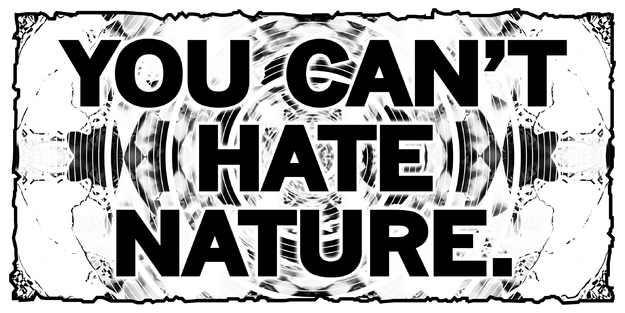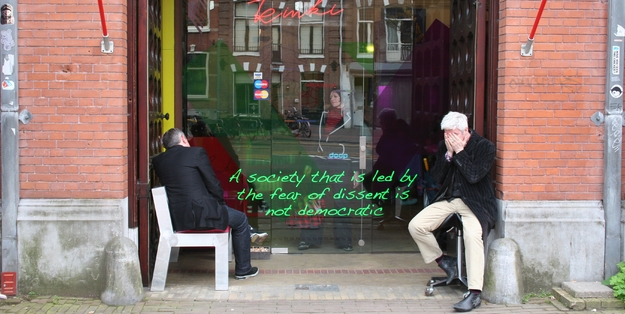The exhibition On Joy, Sadness and Desire is part of the manifestation My name is Spinoza. The manifestation encompasses a contemporary reflection regarding the ideas of the philosopher Spinoza (1632-1677) that aims to pivot a discussion around his central thematics. The distinct relevance of Holland’s most renowned Enlightenment thinker is eminent: Spinoza’s work contains subject matter that govern the current-day public and political debate in The Netherlands, topics such as the freedom of speech, the correlation between citizens and state, religion and the public sphere. On Joy, Sadness and Desire notably invokes these subjects; the exhibition moves beyond the talk of the day and investigates reason and passions as faculties that are intrinsically a part of being human. Therefore the works of art do not only refer to the public and political realm (some pieces are exhibited in the public sphere) but also represent thoughts and feelings that are experienced on an individual and deeply personal level.
The Enlightenment elevated reason as ‘the most noble of human faculties’ and the primary source and legitimacy for authority. However, as Spinoza pointed out in his famous work Ethics (1677), the human psyche is also ruled by desire and other passions. Before he concludes his book by stating that the path to attainable happiness revolves around the outlines of reason, he argues how people are often incapable of being consistently rational or even lucid – human beings are habitually engulfed in the powerful surge of tumultuous desire and impulse. Here Spinoza distinguishes three key sensations, joy, sadness and desire, from which all other emotions emanate.
Spinoza did not pronounce emotions as harmful or destructive per se, but called them bad when they frustrate our striving or decrease our activity and power. Eliminating these disruptive passions contributes to our freedom because it prevents us from being directed by external forces. In the Ethics he suggests certain principles that could liberate us from the constraints of bad passions.
In the light of Spinoza’s work, one could argue that reason and passion are equally important to the attainment of knowledge and in unison play an important role in the enforcement of personal and social change. Hence a good liaison between sense and sensibility is indispensable for leading a good life, both as an individual and as a society at large.
Information about participating artists On Joy, Sadness and Desire
Sebastian Diaz Morales | Tim Etchells | Freee | Mathilde ter Heijne | Pia Lindman | Ioana Nemes Mark Titchner
The Freee art collective updated quotes from Spinoza to invoke discussion about democracy, consensus and power. By printing these statements on shop windows in the local vicinity (as backdrops for photos of which three have been selected and are produced as billboard prints in the exhibition space) Freee make philosophical arguments about issues regarding the world of work, commerce, consumption and everyday life, stemming from the belief that it is of vital importance to any democracy that as many people as possible are actively engaged with it.
In Tim Etchells’ video Kent Beeson is a Classic and an Absolutely New Thing a performer outlines a fantasy of the future – a compilation of lifestyle clichés that mirror the statements of movie stars, rap singers. The common-place dream of exaggerated success and wealth crumbles as the performer becomes more and more flustered, struggling to get through the text he has poorly memorised. Whereas this work seems to mock the capitalist craving for material wealth Etchells’ video Down Time is characterized by sensitive introspection. A silent image of the artist's thinking face is accompanied by his commentary, recorded after-the-fact, attempting to describe the unfolding narrative of his thoughts on the chosen topic of 'goodbyes'.
Mark Titchner created two newly commissioned banners for the exhibition space and one banner to be shown in the city centre. The banners create a link between Spinoza’s ideas on human nature, the loss of freedom, capitalism and migration. The project Sing a B.S. Song consists of songs, posters and a performance, finding their starting point in his fascination for Spinoza’s attempts to create a rational framework around the emotions.
In Mathilde ter Heijne’s sound installation 1, 2, 3,…,10, Ready or Not, Here I Come, ten portable radios transmit political speeches of various origins from the mid 1960s to the late 1990s. Played simultaneously, the radios produce a muddled chorus of revolutionary voices, testifying in ghostly fashion to the persistence of unresolved struggles: a challenge to the belief that politics can pacify.
Sebastian Diaz Morales’ video installation Lucharemos hasta anular la ley (We will fight until annulling the law) takes on the notion of public violence and its catalysing effects. Lucharemos was based on existing news footage from a street protest in Buenos Aires. In front of the parliament a crowd has gathered in order to contest a law that implements more rigorous sanctions for demonstrators and street vendors, threatening their survival and their very being.
Ioana Nemes presents the Vanishing Point series, part of her ongoing project Monthly Evaluations. The Vanishing Point works consist of a selection of three works representing three days that bear a certain similarity. All works present texts which express frustration about the limitations of individual freedom imposed by society – especially concerning individual considered not equipped to take care of themselves.
Pia Lindmans installation Puntila Project – spiritual journeys builds a moment of inner reflection and quiet amidst the multitude of voices in the exhibition: visitors are invited to take part in her scenography and drinking or not, drunk or sober, play out what they think is a state of exalted intoxication. Lindman’s multimedia installation, based on a play by Bertold Brecht and Hella Wuolijoki focuses on a special detail of the Finnish drinking culture and – what she dares to call – its belief system, one part of which seems to include exaltation over nature while drunk and subtly questions the ‘authenticity’ of the emotions fuelled by psycho-chemicals and the (supposed) spiritual insights that could be generated by intoxicating oneself.
On Joy, Sadness and Desire is an exhibition accompanied by off-site projects organized by SMART Project Space as part of the manifestation My name is Spinoza. My name is Spinoza is an initiative of the Amsterdam Spinoza Circle, developed by SKOR (Foundation Art and Public Space) commissioned by Foundation Spinoza Centre Amsterdam.
SMART Project Space is supported by: Mondriaan Foundation, Gemeente Amsterdam, Bureau Broedplaatsen, Stichting DOEN, The Netherlands Film Fund, Prins Bernhard Cultuurfonds, VSBfonds, Amsterdam Fund for the Arts. The exhibition On Joy, Sadness and Desire is further supported by SKOR and the Amsterdam Fund for the Arts.

